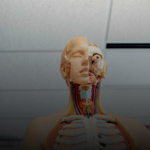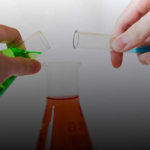Section 1
Preview this deck
Monoclonal Antibodies
Front
Active users
0
All-time users
0
Favorites
0
Last updated
5 years ago
Date created
Mar 14, 2020
Cards (79)
Section 1
(50 cards)
Monoclonal Antibodies
Antibodies produced by a single B lymphocyte that has been selected and that produces a single type of antigen.
Spermatogenesis
Process of sperm production—begins at puberty and continues throughout life. Spermatogonia (2n) give rise to two primary spermatocytes by mitotic cell division, ensuring a permanent supply of cells to undergo spermatogenesis.
Embryonic Induction
The ability of 1 group of embryonic cells to influence the development of another group of embryonic cells by switching on certain genes.
Secretion
Selective reuptake of molecules that did not get filtered into Bowman's capsule. Occurs by active transport and in the proximal and distal tubules.
Passive Immunity / Active immunity
Passive; temporary. Antibodies are transferred from another animal. Ex; a mother transfers some of her antibodies (in colostrum to her nursing child. Active Immunity; permanent. Individual makes own antibodies. The result of being sick and recovering or from receiving a vaccination.
Macrophages
Developed from monocytes, they migrate though blood or reside in tissues; they kill and digest large numbers of germs using their lysosomes. Display MHC II molecules on their surfaces.
Second line of defense
Nonspecific defense; Pryogens increase body temp to speed up the immune system. Complement is a group of protein that helps to destroy microbes by rupturing there membranes. Interferons are chemicals that block infections. Natural killers destroy infected body cells.
Microvilli
Cytoplasmic extensions from each epithelial cell, make up the Villi and further increase surface area and absorption; they give the lining of the small intestine a velvety appearance called a brush border.
Anaphylactic Shock
Acute, extreme allergic reaction. Life threatening. Results from sudden dilation of blood vessels, which results in precipitous drop in blood pressure.
B Lympphocytes
Humoral response-produce antibodies, activated by T cells or by free antigens in blood, secrete 200 antibodies/second over the cells 4-5 day life span, proliferate into plasma and memory cells, part of specific immune response
Digestion in the Stomach
Mechanical (churning action of muscular wall), Chemical (protein digestion begins here), Gastric Pits line stomach wall and contain parietal and chief cells (Parietal cells release hydrochloric acid, Chief cells release pepsinogen (an inactive form of pepsin which is then activated by the hydrochloric acid)).
Second Line of Defense
Nonspecific defense. Inflammatory response is initiated by chemical signals and characterized by redness, swelling, and warmth; the goal is to attack and isolate invading microbes. Histamine triggers vasodilatations which increases blood supply to an area, bringing phagocytes. Phagocytes ingest invading microbes. Prostaglandins further enhance blood flow to area. Chemokines, secreted by blood vessel endothelium and monocytes, attract more phagocytes to the area.
Function of Human Kidney
Basic functional unit = nephron. Removes metabolic wastes - urea. Acts as an osmoregulator - adjusts both volume and concentration of urine depending on several factors (intake of water, salt, and production of urea from protein metabolism).
Digestive Enzymes
Amylase (hydrolyzes starch; released in mouth and small intestine), Pepsin or Peptidase (hydrolyzes protein; protein digestion begins in the stomach. Trypsin and chymotrypsin are released into the small intestine by the pancreas), Lipase (digests lipids into glycerol and fatty acids; released by small intestine).
Colon (large intestine)
Removal of undigested waste. Re-absorption of excess water into bloodstream. Vitamin K and B production by bacteria.
First Line of Defense
Keeping germs out with nonspecific barriers, such as skin, stomach acid, mucous membranes producing lysozyme, and cilia in respiratory system.
Autoimmune diseases
A Mistake in the immune system where the body does not properly distinguish self from nonself. The immune system attacks its own body tissue. Ex; multiple sclerosis, lupus, arthritis, and juvenile diabetes.
Organogenesis
Process by which cells continue to differentiate, producing organs from 3 embryonic germ layers.
Cleavage
Rapid mitotic division of the zygote that begins immediately after fertilization.
Gastrulation
Process that involves rearrangement of the blastula and begins with the formation of the blastula and results in the formation of 3 differentiated layers called embryonic germ layers.
Hormone Control of Nephron
Antidiuretic hormone. Rennin-Angiotensin-Aldosterone System.
Nephron
Consists of glomerulus, bowman's capsule, proximal tubule, loop of Henle, distal tubule, and collecting tubule or duct. Steps = Filtration, secretion, reabsorption, excretion.
MHC I
MHC I molecules are found on almost every body cell, bind to cytotoxic T cells
Reabsorption
Process by which most water and valuable solutes that entered tubule during filtration are transported back into capillaries and, thus, back to the body. Occurs by passive and active transport. Occurs mainly in loop of Henle and collecting tubule. Water flows from nephron hypertonic surrounding tissue and then into capillaries.
Epiglottis
Flap of cartilage in the back of pharynx. Directs food into the esophagus or air into lungs.
Antidiuretic Hormone
Part of feedback mechanism that responds to changes in concentration of blood. Released by posterior pituitary. Increases permeability of collecting tubule to water so water can be reabsorbed back into blood, thus reducing excessive water loss through urination.
Human Organs of Excretion
Skin excretes water and nitrogenous wastes in sweat. Lungs excrete CO2 and water vapor. Kidneys excrete nitrogenous waste and excess water. Liver is the site of deamination and where urea is produced.
Allergies
Hypersensitive immune responses to certain substances alled allergens that cause the release of histamine.
Embryonic Germ Layers
Ectoderm becomes skin and nervous system. Mesoderm becomes blood, bone, and muscle. Endoderm becomes viscera, digestive tract.
Liver - Digestive
Produces the emulsifier bile, which is stored in the gallbladder. Homeostasis: stores sugars as glycogen. Excretory: deamination of amino acids and production of nitrogenous wastes, such as urea. Transport: synthesizes blood plasma proteins important in blood clotting. Detoxification: breaks down alcohol and other toxins.
Overview of Immunes System
Specificity - specialized cells have different jobs and respond only to certain cues. Diversity - a wide variety of different cell types that operate in our defense. Memory - B and T memory cells that circulates for a lifetime. Capacity to distinguish self from non-self - we only become aware of this protection when the system goes awry.
Cardiac Sphincter
Band of muscle at the top of stomach that keeps food from backing up into esophagus, causing digestion or heartburn.
Hormones That Regulate Digestion
- Gastrin-Secreted by stomach wall. Stimulates secretion of gastric juice. Secretin -Secreted by duodenal wall. Stimulates pancreas to release bicarbonate ion HCO3- to neutralize stomach acid. Cholecystokinin-Secreted by duodenum. Stimulates pancreas to release pancreatic enzyme and gallbladder to release bile into small intestine.
MHCII
MHC II molecules are found on macrophages, B cells and activated T cells, bind to helper T cells
Blood ABO Antigens and Antibodies
Type A has A antigens and anti-B antibodies in plasma. Type B has B antigens and anti-A antibodies in plasma. Type AB has A and B antigens and no antibodies in plasma. Type O has no antigens and anti-A and -B antibodies in plasma.
Gray Crescent
Part of the cytoplasm of the frog embryo that is necessary for normal development into adulthood. Appears on side of egg opposite where sperm penetrates. Blastopore forms at border of gray crescent and vegetal pole after fertilization. Spemann's classic experiments - only the zygote containing the gray crescent developed properly. Spemann proved that the cytoplasm plays a major role in embryonic development.
Villi
Finger like projections that line small intestine, thus increasing surface area to increase absorption of nutrients into blood.
Oogenesis
Characterized by unequal cytoplasmic division and the formation of only 1 active ovum. Meiosis I begins in the first trimester in utero and then and then stops. Meiosis II proceeds when fertilization occurs.
Plasma Cells
fight current infection
AIDS
Acquired immunodeficiency syndrome, caused by HIV, a retrovirus, attacks cells that bear CD4(helper T cells) molecules on their surface
Bile
Produced in the liver and stored in gallbladder. An emulsifier that mechanically breaks down fats into smaller fat molecules.
Digestion
Intracellular digestion is carried out inside all animal cells in food vacuoles and lysosomes. Extracellular digestion is carried out outside the cells in the stomach in complex animals or in gastrovascular cavity in primitive animals like the hydra.
Small Intestine
Completion of all digestion and absorption of nutrients. First 10" is the duodenum, where most figestion is completed. It secretes hydrolytic enzymes (amylases, proteases, lipases, nucleases). Inner walls are lined with villi and microvilli which greatly increase absorption of nutrients into blood. 6 metres long in adult humans.
Nitrogenous Wastes
Ammonia - Very soluble in water and highly toxic. Generally excreted by organisms that live in water, including hydra and fish. Urea - Not as toxic as ammonia. Excreted by earthworms and humans. In mammals, formed in liver from ammonia. Uric Acid - Pastelike substance that is not soluble in water and therefore not very toxic. Excreted by terrestrial animals.
Extraembryonic Membranes in the Chick Egg
Yolk sac encloses the yolk and providees food for the growing embryo. Amnion encloses the embryo in protective amniotic fluid. Chorion lies under the shell and allows for diffusion of respiratory gases between the outside and the growing embryo. Allantois is analogous to the placenta in mammals; carries respiratory gases between environment and embryo and is a repository for the nitrogenous waste, uric acid.
Pyloric Sphincter
Band of muscle that regulates the passage of chime (partly digested food plus stomach acid) moving from stomach to small intestine.
Filtration
Molecules diffuse from the glomerulus into Bowman's capsule. Occurs by passive transport. Nonselective. The liquid that filters into the capsule is called filtrate.
Excretion
Removal of metabolic wastes. Nitrogenous wastes from protein metabolism. CO2 from cell respiration. Water from cell respiration.
Rennin - Angiotensin - Aldosterone System
Part of a feedback mechanism that responds to decreases blood pressure, which can result from excessive sweating or inadequate fluid intake. Stimulates kidneys to reabsorb more water and causes arterioles to constrict. Stimulates adrenal glands to release aldosterone, which causes kidneys to reabsorb more water. Increase blood pressure.
Asexual Reproduction Examples
Fission (divison of an organism into 2 cells, like an amoeba), Budding (splitting off of new individuals from existing ones, like a hydra), Fragmentation/regeneration (when a single parent breaks into parts to regenerate into new individuals, like sponges and sea stars), Parthenogenesis (development of an egg without fertilization, the resulting adult is haploid, in honey bees and some lizards).
Section 2
(29 cards)




